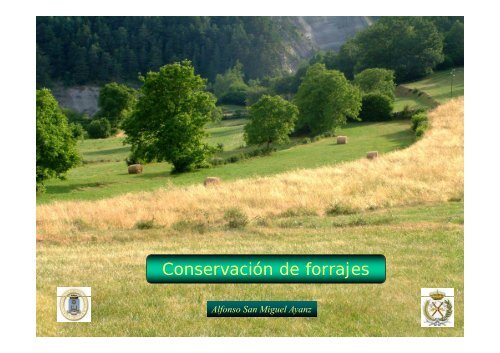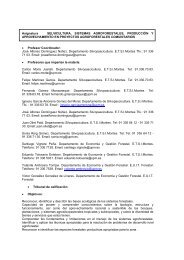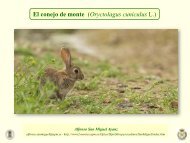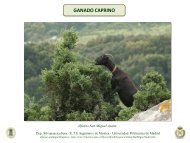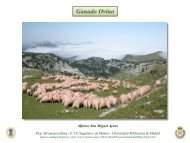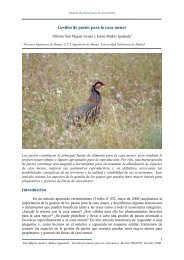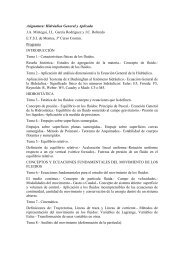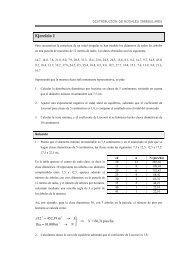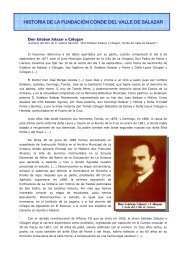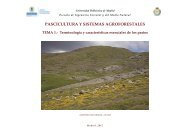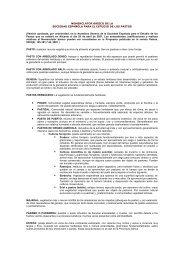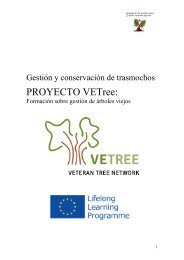Conservación de forrajes
Conservación de forrajes
Conservación de forrajes
Create successful ePaper yourself
Turn your PDF publications into a flip-book with our unique Google optimized e-Paper software.
<strong>Conservación</strong> <strong>de</strong> <strong>forrajes</strong><br />
Alfonso San Miguel Ayanz
CONSERVACIÓN DE LOS FORRAJES<br />
¿ POR QUÉ SE CONSERVAN LOS FORRAJES ?<br />
• Mala distribución estacional <strong>de</strong> la producción<br />
• Sanidad animal (meteorismo, tetania, humedad)<br />
• Estabilidad cualitativa <strong>de</strong> la dieta (MS (MS, UF UF, MND MND...) )<br />
• Posibilidad <strong>de</strong> <strong>de</strong>gradación <strong>de</strong>l pasto<br />
¿ QUÉ FORRAJES SE COSECHAN ?<br />
• Los <strong>de</strong> calidad (prados <strong>de</strong> siega, cultivos forrajeros). Se pier<strong>de</strong> cantidad y calidad<br />
• Los subproductos agrícolas (paja y otros). Cantidad<br />
• EEn algunos l casos, el l ramón ó<br />
PRINCIPALES SISTEMAS DE CONSERVACIÓN DE FORRAJES<br />
• HENIFICACIÓN (natural o artificial)<br />
• ENSILAJE<br />
• DESHIDRATACIÓN<br />
CRITERIOS DE ELECCIÓN<br />
•Coste<br />
• Calidad<br />
• Mano <strong>de</strong> obra<br />
• Maquinaria
HENIFICACIÓN<br />
• CONCEPTO: Secado rápido <strong>de</strong>l forraje, hasta un 15-20% <strong>de</strong> humedad (mínimas pérdidas)<br />
• TIPOS: natural o artificial
-Siega: momento óptimo<br />
* cantidad-calidad<br />
* clima: seguridad <strong>de</strong> sequedad ( < 60%) y temperatura (> 15ºC)<br />
EVOLUCIÓN<br />
DE LA<br />
OFERTA<br />
DE HIERBA<br />
CON LA<br />
FENOLOGÍA<br />
Crecimiento<br />
vegetativo<br />
GRAMÍNEAS LEGUMINOSAS<br />
UF/kg MS<br />
g MND/kg MS<br />
Biomasa<br />
Formación<br />
tallos florales<br />
UF/kg MS<br />
g MND/kg MS<br />
P = 25%<br />
P = 36%<br />
P = 46%<br />
P = 65%<br />
Floración
- Siega e hilerado: sistema (guadaña, motosegadoras alternativas o rotativas)<br />
Motosegadora alternativa (<strong>de</strong> peine)
Segadora rotativa <strong>de</strong> tambores
Acondicionado <strong>de</strong>l forraje: compresión para aplastar tallos y acelerar y homogeneizar la<br />
velocidad <strong>de</strong> secado<br />
* Crusher (Aplastadores)<br />
* Crimper (Quebrantadores)<br />
Reducen ~ 2 días<br />
la duración <strong>de</strong> la<br />
henificación<br />
Acondicionador<br />
<strong>de</strong> <strong>forrajes</strong>
Interior <strong>de</strong> acondicionadores <strong>de</strong> forraje j
Segadora - acondicionadora
- Volteo (1-2 veces al día), esparcimiento e hilerado (Volteadoras-hileradoras)
Volteadora –<br />
hileradora<br />
<strong>de</strong> discos
Volteador – hilerador <strong>de</strong> peines
edad (%)<br />
Hum<br />
80<br />
60<br />
40<br />
20<br />
Exten<strong>de</strong>r-Voltear<br />
Reunir<br />
Tiempo bueno<br />
Acondicionado + tiempo bueno<br />
Tiempo regular<br />
Día 1 Día 2 Día 3 Día 4 Día 5
- Recogida: * horca,<br />
* pacas paralelepipédicas l l i édi ( (normales, l ~ 20 kkg, o gran<strong>de</strong>s, d ~ > 200 k kg), )<br />
* rotopacas (250 kg paja, 500 kg heno)
Empacadora <strong>de</strong> pacas<br />
paralelepipédicas
Rotoempacadora (en este caso <strong>de</strong> hierba ver<strong>de</strong>)
- Almacenamiento: * almiares (tradicionales y prismáticos)<br />
* heniles ( ~125 kg/m 3 ),<br />
* rotopacas a la intemperie<br />
Almiares
HHenil il con rotopacas<br />
t
Henil lleno <strong>de</strong> pacas <strong>de</strong> paja
• PÉRDIDAS É EN LA HENIFICACIÓN: Ó Media 10 - 25 (35) %<br />
- Por oxidación (respiración) 10 - 15%<br />
- MMecánicas á i 2 - 35%<br />
- Por fermentación 3 - 5%<br />
- Por lavado (elementos ( minerales) )<br />
- Por el sol (<strong>de</strong> caroteno)<br />
- Por empacado<br />
Si llueve durante la henificación, las pérdidas pue<strong>de</strong>n incrementarse<br />
notablemente<br />
Las pérdidas son <strong>de</strong>:<br />
-MS<br />
- Energía<br />
- MND<br />
- Minerales, Vitaminas<br />
- Palatabilidad
• SISTEMAS PARA REDUCIR LAS PÉRDIDAS EN LA HENIFICACIÓN:<br />
- Fecha <strong>de</strong> siega => ¿Coinci<strong>de</strong>ncia con fenología óptima?<br />
- Salazón (1-3% sobre peso total), ácido propiónico<br />
- Secadores <strong>de</strong> forraje<br />
- AAcondicionadores di i d <strong>de</strong> d <strong>forrajes</strong> f j<br />
* Crusher (Aplastadores)<br />
( p )<br />
* Crimper (Quebrantadores)
HENIFICACIÓN ARTIFICIAL<br />
- Paso <strong>de</strong> aire caliente forzado a través <strong>de</strong> forraje semi-seco semi seco (40-60% (40 60% humedad)<br />
- Se aplica sobre forraje sin empacar o empacado, bajo cubierta<br />
- Diversos sistemas<br />
* Circulación horizontal<br />
* Circulación vertical<br />
- No utilizado en España, por el clima, y algo en C y N <strong>de</strong> Europa
VALORACIÓN DE LA CALIDAD DEL HENO<br />
Análisis bromatológico<br />
El aspecto exterior suele estar muy relacionado con la calidad <strong>de</strong>l heno<br />
• Color : 10 puntos: ver<strong>de</strong> (10); <strong>de</strong>scolorido (0); enmohecido (-10)<br />
• Olor: 5 puntos: bueno (5); inodoro (0); fuertemente enmohecido (-20)<br />
• Tacto: 10 puntos: tallos flexibles y con hojas (10); tallos duros y con pocas<br />
hojas (0); muy húmedo (-10)<br />
• IImpurezas: 5 puntos: t muy pocas (5) (5); pocas (0) (0); mucho h polvo l y plantas l t perju- j<br />
diciales (-10)
EL ENSILADO<br />
CONCEPTO: Forraje fresco conservado mediante fermentación anaerobia<br />
Características similares a las <strong>de</strong>l forraje original (algo peores)
PROCESO DEL ENSILAJE<br />
- Corte <strong>de</strong>l forraje. Posibilidad <strong>de</strong> segadora-picadora<br />
- Cierre hermético en silo<br />
- Respiración celular: CO 2 , H 2O y calor<br />
- AEROBIOSIS: microorganismos aerobios<br />
Células vivas<br />
Pérdida <strong>de</strong> HHCC (unas 5 h)<br />
- Acidificación. Fermentación acética (bacterias coliformes): ácido acético<br />
- ANAEROBIOSIS ANAEROBIOSIS. pH bajo => > Fermentación láctica (lactobacilos)<br />
Conversión <strong>de</strong> azúcares en ácido láctico<br />
Acidificación<br />
- Estabilización, a pH < 4 - 5 (<strong>de</strong>pen<strong>de</strong> <strong>de</strong> %MS)<br />
- Si pH > 4 => Fermentación butírica (Clostridium) => Proteolisis, NH 4 +<br />
pH<br />
6,0<br />
5,0<br />
40ºC<br />
4,0 20ºC<br />
1............7.....................................................18-21 (Días)<br />
30ºC Temp
CONDICIONES PARA CONSEGUIR UN BUEN ENSILADO<br />
- FORRAJE: * alto contenido en HHCC <strong>de</strong> ca<strong>de</strong>nas sencillas<br />
* gramíneas, í lleguminosas; i ffenología l í<br />
* M.S. : óptimo 30-35%<br />
- ANAEROBIOSIS<br />
-TROCEADO TROCEADO Y PICADO<br />
- ADITIVOS para: p<br />
* Estimular la fermentación láctica ( cont. azúcares):<br />
- Azúcares (más cuanto menor sea el contenido en MS <strong>de</strong>l forraje)<br />
- Melazas (3-4%), (3 4%), pulpa <strong>de</strong> remolacha<br />
* Acidificar: Acido fórmico (2-5 kg/t <strong>de</strong> forraje ver<strong>de</strong>),<br />
Mezcla Virtanen AIV: 0,3ClH+0,7SO4H2 2N<br />
* Inhibir actividad <strong>de</strong> bacterias in<strong>de</strong>seables (ya no se usan):<br />
- Formol o ácido fórmico + formol<br />
glucosa<br />
sacarosa<br />
fructosa<br />
maltosa
TIPOS DE SILOS ZZanja j PPozo<br />
Trinchera o corredor Almiar<br />
Torre<br />
Depósito<br />
Bolsa<br />
Silo zanja
Silo zanja abierto
Silo torre
Silo trinchera
Compactación <strong>de</strong>l forraje con tractor en silo trinchera
Lixiviados <strong>de</strong> silo trinchera (muy contaminantes)
Silo trinchera abierto
Silo almiar, antes <strong>de</strong> cubrir
Silos bolsa
Plastificado<br />
d<strong>de</strong> rotopacas<br />
t
CARACTERÍSTICAS DEL BUEN ENSILADO<br />
* Color ver<strong>de</strong> claro * Acido láctico > 3% peso fresco<br />
* Ol Olor a ffruta t algo l agria i * AAcido id acético éti < 0,5% 0 5%<br />
* MS: 30 a 35% * Acido butírico < 0,3%<br />
* N amoniacal/N total < 10%<br />
* pH < 5<br />
VENTAJAS E INCONVENIENTES (frente a heno)<br />
* Más MS por p unidad <strong>de</strong> volumen * Mayor y peso p<br />
* Sin riesgos climáticos * Lixiviados<br />
* Apto para hierba joven * Selectividad<br />
* Sencillo y barato * Problemas con ganado lechero<br />
* Alta palatabilidad => > mayor ingestión
DESHIDRATACIÓN DE FORRAJES
Trommel <strong>de</strong> entrada <strong>de</strong>l forraje para <strong>de</strong>shidratación
Interior <strong>de</strong> planta <strong>de</strong>shidratadora <strong>de</strong> alfalfa
Alfalfa <strong>de</strong>shidratada en rama
Empacadaora <strong>de</strong> alfalfa <strong>de</strong>shidratada
Pacas <strong>de</strong> alfalfa <strong>de</strong>shidratada en rama <strong>de</strong> 800 kg/u
Alfalfa <strong>de</strong>shidratada en tacos


